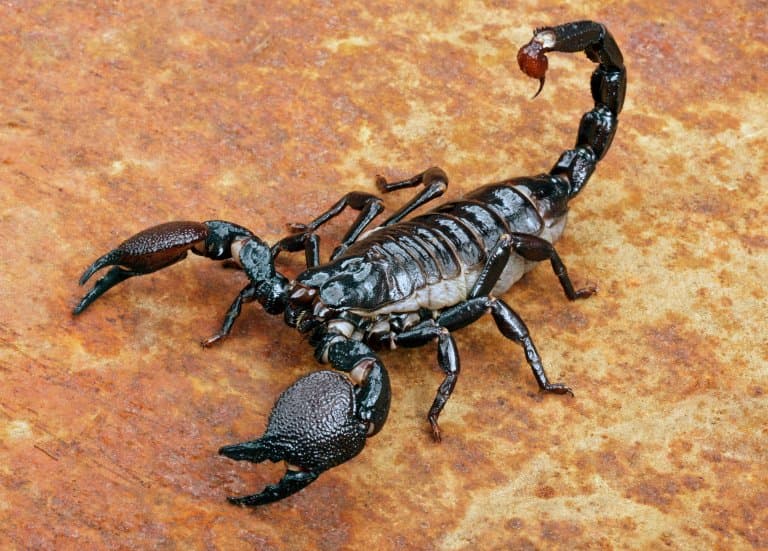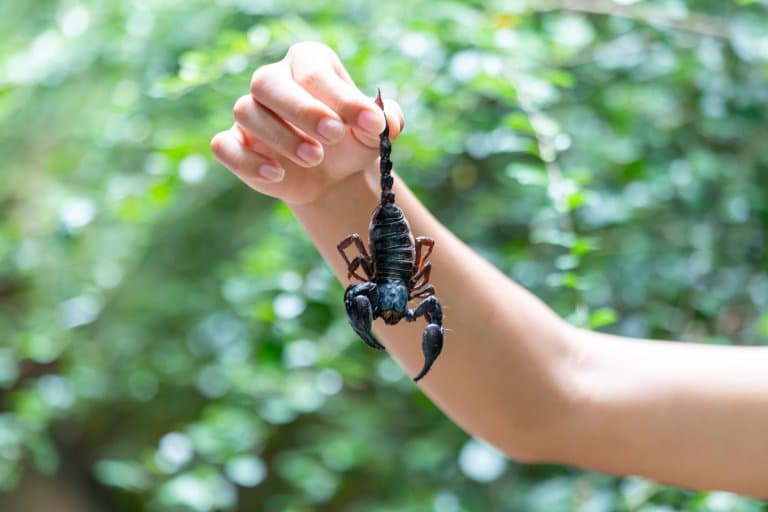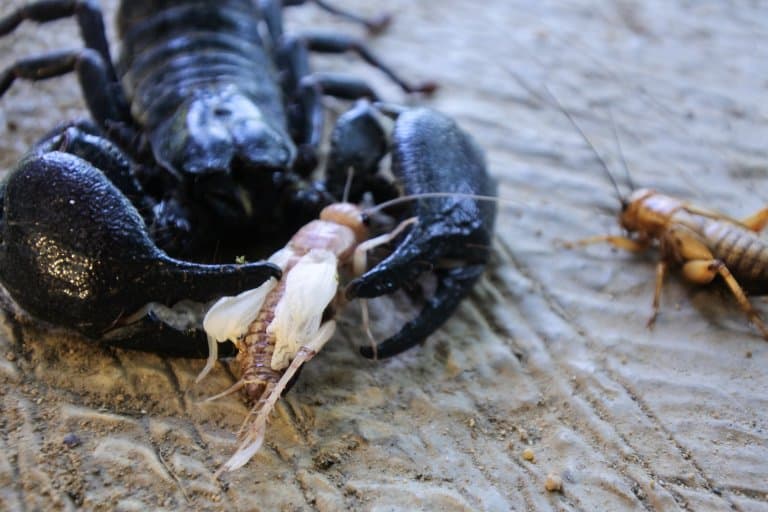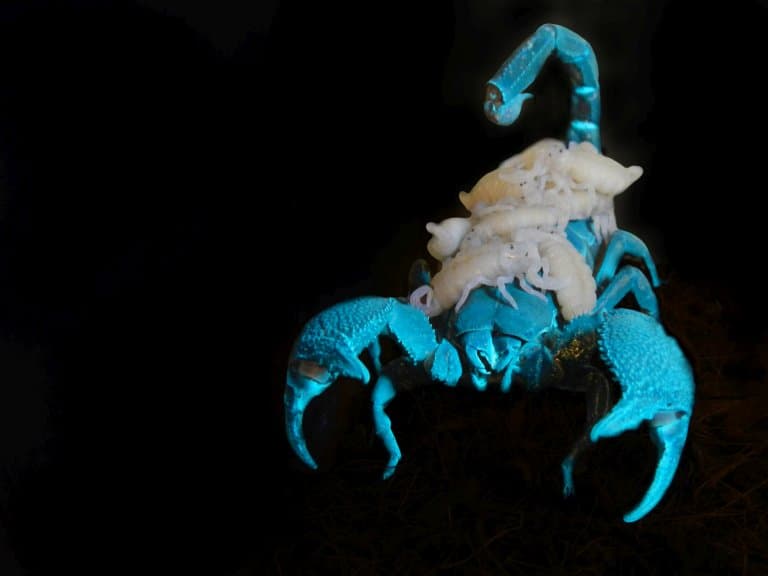Emperor Scorpion Profile
Scorpions are one of those animals that show up in imagery and iconography of human cultures across the world and for as long as we can tell. They seem to symbolise an ancient power and tap into that triangulated sweet spot between fear, disgust and awe.
And perhaps that’s for good reason because there are few animals alive today who have shared our ancient path for so long. When our ancestors dragged their scaly butts out of the water, scorpions were there to greet us. And, probably eat us.
And while we’ve been through fish, amphibian, reptile and squirrel stages to get to where we are, scorpions have just been there, being scorpions.
The Emperor scorpion is one of the largest scorpion species living today that is native to tropical rainforests and savannas of West Africa.

Emperor Scorpion Facts Overview
| Habitat: | Tropical forests and savanna |
| Location: | West Africa |
| Lifespan: | Up to 8 years |
| Size: | 23cm (9inches) long |
| Weight: | 32g |
| Colour: | Black |
| Diet: | Insects and other invertebrates, mostly termites, also lizrds and small mice |
| Predators: | Birds, bats, mammals, lizards, spiders (when young) |
| Top Speed: | Slow |
| No. of Species: | 1 |
| Conservation Status: | Not Listed |
The Emperor scorpion will inhabit both tropical forests and savannas, and will often burrow beneath the soil, or hide under rocks.
They spend their time hunting termites, but will also eat vertebrates, such as lizards and rodents.
Emperor scorpions are probably the largest species of scorpion we have left, and they’re a little different than most. Docile, and content with digging into termite mounds for food, they make good exhibits in exotic pet collections.
But this popularity might threaten the species, and more regulation is needed to curb an inevitable decline if the industry keeps overharvesting from the wild.
Interesting Emperor Scorpion Facts
1. They’re one of the largest species of scorpion
At least, by modern standards. The largest scorpion we know of, over the entirety of their 437-million-year existence, was the 3-foot-long Brontoscorpio that lived around 415 million years ago. This one was discovered, of all places, in Worcestershire, England.
Since then, they have downsized somewhat, but the emperor is one of, if not the biggest. They grow up to an average of 20 cms (8 inches) in length.
These scorpions are consistently the longest on record, though there is a report of a 12-inch giant Forest Scorpion from India. 1

2. Emperor scorpions are social
Unlike many scorpion species, emperors are social animals. And unlike many emperors, they’re monogamous, too!
These scorpions will live in small communal groups and seem to tolerate each other better than any other species. Their relatively social nature is tied to just how peaceful they are.2
3. They’re not dangerous
There are very few scorpions amid the 2,000+ species on Earth that pose a significant threat to people. From 1.5 million envenomations being reported each year, only 2,000 – 3,000 deaths are recorded worldwide.
Despite their enormous size and powerful-looking stingers, Emperor scorpions are very innocuous animals to mammals our size.
As a general rule (and definitely not to be relied upon as absolute) scorpions with giant claws (or pincers) have weaker stings. This is because they don’t typically need both; a strong killing grip reduces the need for a powerful venom, and vice versa.
Emperors are also timid, and are only ever aggressive after giving birth, which makes them easy to handle and care for. 3
4. They’re good for you
Not only are these animals great pest control, but their venom might be medically significant in a good way.
Along with countless other species of venomous arthropods, the emperor scorpion is being studied for its potential use in antimicrobial medicine. Their venom contains interesting peptides that show promise as an antibiotic, and with the efficacy of antibiotics currently plummeting, this is potentially world-changing.
But on a closer-to-home scale, these are great animals to have around the house and garden, as their diet consists of many of the animals we consider pests. 4
5. They are fearless termite hunters
While they can eat much larger animals, emperor scorpions have a hankering for termites. In their native habitat, the giant grasping mitts of the emperor scorpion are used to tear into termite mounds, digging extensively into the mound almost two meters deep to access the juiciest morsels.
Smaller scorpions will use their stings to disable their prey, but as their pincers grow, this becomes less common. In fact, adult emperor scorpions will rarely, if ever, sting.

6. They’re popular pets
This lack of aggression, combined with their large size and striking black colour makes them very popular among exotic pet collectors.
They’re easy to keep, they don’t move much, and they’ll eat all the classic exotic food stock like crickets and locusts.
In good care, they can live up to 8 years, which does make them a bit of a commitment, and they’re not super easy to breed, which has led to issues of overharvesting.
7. This is causing them problems
The breeding cycle of these large scorpions is slower than average. While many species will have tens of scorpions in a litter, emperors have closer to 12. Then, sexual maturity takes another four years, making for a long generational time.
They are a pearly white when born and these youngsters are called ‘scorplings’.
Interestingly, when they get too big and heavy to be carried on her back, the mother will shake them off to send them on their way.
Any that tries to hold on will be eaten. But this isn’t their major threat. Their popularity makes them a target for over-harvesting, as collecting individuals for foreign markets can be a lucrative pursuit in West African countries.
While they’re not listed on IUCN, they are now restricted by CITES, the governing body over the control of trade in endangered species. This species is classified as “should be carefully monitored and controlled”.
8. Emperor scorpions glow green and blue
This is a very strange phenomenon that nobody fully understands yet, but scorpions are well known for glowing under UV light.
Many will glow green or yellow, but emperor scorpions glow a beautiful murky blue-green colour. This ability is a bit of a mystery but it might have something to do with how they find one another at night.
But one hypothesis might be closer to the truth. Even with eyes blocked, scorpions appear to be sensitive to UV light, meaning that they could use their entire bodies as light detection devices, being able to ‘feel’ which parts of their bodies are exposed to light and helping them hide more effectively. 5

Emperor Scorpion Fact-File Summary
Scientific Classification
| Kingdom: | Animalia |
| Phylum: | Arthropoda |
| Class: | Arachnida |
| Order: | Scorpiones |
| Family: | Scorpionidae |
| Genus: | Pandinus |
| Species: | Pandinus Imperator |
Fact Sources & References
- “Largest arachnid (current)”, Guiness World Records.
- “Emperor Scorpion”, Idaho Falls.
- Shirin Ahmadi (2020), “Scorpion Venom: Detriments and Benefits”, NIH.
- Gerardo CORZO (2001), “Characterization of unique amphipathic antimicrobial peptides from venom of the scorpion Pandinus imperator”, Portland Press.
- “Emperor scorpion (Pandinus imperator) glowing blue under UV light”, Nature Picture Library.
